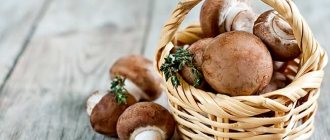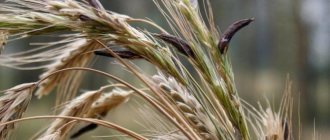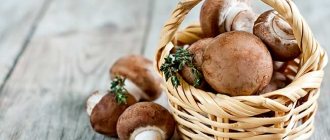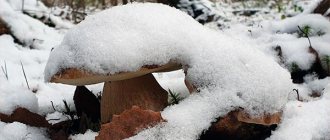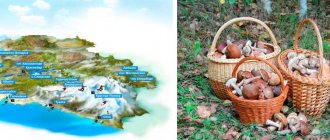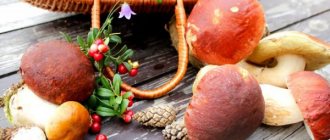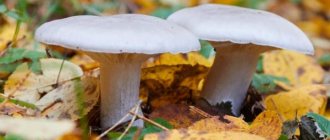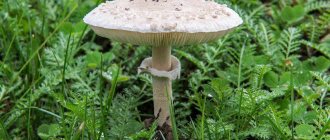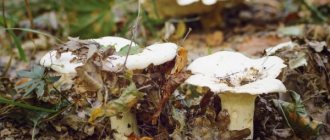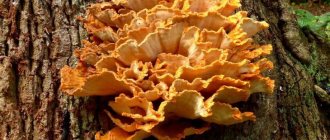Where are conditionally edible mushrooms used?
Semi-edible mushrooms are usually rich in beneficial substances, so they are used for medicinal purposes. Modern medicine and pharmaceuticals extract many healing properties from these mushrooms that can affect the outcome of a serious illness.
Semi-edible mushrooms are widely used in medicine to treat various diseases. Not all healthy components have been studied, but those that are known are effectively used for the prevention and treatment of diseases, in dietetics and cosmetology.
Useful properties of nigella
Nigella has a large list of beneficial properties, as well as vitamins that are included in the product. The plant contains a lot of vitamins from group B and PP. In addition, they contain folic acid, which is necessary for people who are planning to have a child.
Naturally, the amount of elements is not so great as to saturate the human body to the fullest extent, but if you include such a product in your diet, you can get a certain amount of useful elements.
Biological elements and vitamin C help strengthen the immune system and also improve metabolic processes.
The cap of such a plant contains a minimal amount of fat, this makes nigella very valuable for individuals who are trying to lose weight and constantly use a variety of diets.
In addition, the amount of protein in the composition is several times greater than that of other conventional meat products. This plant is allowed to be used as food for people with diabetes, because it contains a minimum of natural sugar, which means that nigella is not able to affect fluctuations in the patient’s blood sugar.
Nigella will be most beneficial if used in salted form.
During the fermentation period, the product releases substances that can relieve inflammatory processes in the body; in addition, such a product can be used for treatment.
In this case, you will need to eat it 3 times a week and it will be possible to remove even festering wounds.
Mushrooms cope well with liver diseases, prevent the formation of kidney stones, the product is able to restore a person after an illness and saturates the body with strength when exhausted.
People who suffer from depression, constant stress at work or at home, this product is very necessary, because thanks to the B vitamin, you can normalize and calm your nerves.
Vitamin D, which the mushroom contains, can improve human hair and skin.
The nigella mushrooms shown in the photo will allow you to get a closer look at their visual description.
To take or not to take
The main part of semi-edible mushrooms has a pleasant taste and nutritional qualities. The most important thing is to correctly identify them and prepare them accordingly. If a mushroom picker makes a mistake by confusing a conditionally edible mushroom with an inedible one, or does not subject it to proper culinary processing, the matter may result in health problems, even death.
It is important to know and follow the rules for preparing semi-edible mushrooms
Tubular conditionally edible mushrooms
Tubular, conditionally edible mushrooms have strong caps and look attractive. But they still need to be distinguished from their completely edible counterparts.
Wolf boletus
The semicircular boletus cap has red-pink dry skin. Its diameter reaches 5-10 cm. The short yellow leg thickens towards the middle and turns blue when pressed. The pulp is light yellow, tender. The taste and smell do not stand out at all. These mushrooms grow in clusters in northern Israel. They can be found from November to January.
Wolf's boletus is a large and beautiful mushroom growing in the northern regions of Israel.
Poddubovik
The first boletus mushrooms appear in June, but the period of rapid growth begins in August and continues until November. It grows in oak groves, but it can also be found next to birch, linden, and beech trees.
This mushroom can be confused with the poisonous satanic mushroom. The main difference: the underburden turns blue at the site of the cut, then darkens, the satanic one turns red and eventually becomes light.
There are two types of butterfly: ordinary (olive-brown) and speckled.
Podubovik usually grows in oak forests and other deciduous forests
Common dubovik
It has a massive yellowish leg with a thin brownish mesh and a semicircular cap of light olive-brown color.
Speckled oakweed
Reddish scales are scattered along the thick yellow stem. The cap is dry and velvety, has a dark brown color.
Common and speckled oakweed
Ruby oiler
The hemispherical cap is yellow-brown or brick-red. The massive cylindrical leg is painted pinkish. Under the cap there is a red tubular layer. Yellow pulp, colorless and odorless. Grows in oak groves. Rarely seen.
Ruby oiler is a rare Red Book species, found on decaying oak wood
Goat oiler
It has a slimy and sticky light brown cap and the same stem. The tubular layer is rusty. The pulp is yellowish. About half of the mushrooms found turn out to be wormy. Found in temperate climates in spruce and pine forests. It grows after heavy rains.
Loves sandy soil. Found from July to September.
Goat oiler and Siberian oiler
Siberian oiler
The slimy yellowish cap is overgrown with brown fibers and reaches 4-10 cm in diameter. The thin brown leg is 1-1.5 cm thick. The flesh is yellow. Grows in Siberia and the Far East in coniferous forests. Settles in large groups under cedar trees. Found between August and September.
Fir oiler
The dirty yellow cap, reaching 4 cm in diameter, is covered with brown scales, condensing towards the center. A thin curved stalk, reaching 4 cm in diameter, is covered with conical warts. The olive-yellow or orange-yellow tubes are arranged in radial rows.
The fir oil can has a wide convex cap with an uneven edge, painted dirty yellow.
Grows under fir trees in mixed and cedar-fir forests. The growth period is from July to September.
Oiler gray
The cap is cushion-shaped and light gray with a green or purple tint. It reaches 10 cm in diameter. The dense stem with a white felt ring reaches 8 cm in height. The tubular layer is grayish-white. The pulp is white and watery, turning blue at the break. Gray oiler grows in clusters in pine and larch forests.
Gray oiler - a small tubular mushroom with a smooth, hemispherical cap
Red-spore porphyry
It has a matte brown cap with an indefinite cushion shape and red-brown spores. The diameter of the cap reaches 5-9 cm, the length of the stem is 10-12 cm. On damp soil, mushrooms grow with elongated stems, on dry soil - with short ones. The pink-yellow tubes turn blue-green when pressed.
Belongs to rare species listed in the Red Book. Rich in carbohydrates and proteins.
Red-spored porphyry and false birch
Porphyry false birch
A cushion-shaped cap with a diameter of 4-12 cm of a velvety gray-brown color. The gray pulp becomes black-brown when pressed and has an unpleasant taste and smell. It grows in the forests of Europe, Asia and North America.
Wood flywheel
Beige, golden or brown mushrooms. The hemispherical light cap becomes saturated in old age. The pores are mustard-colored and turn dark blue when pressed. Grows in Europe and North America. Lives on stumps, sawdust, roots, fallen coniferous trees.
Belongs to rare species of mushrooms.
Wood flywheel is an edible tubular mushroom that grows singly or in groups.
Lamellar conditionally edible mushrooms
The assortment of lamellar conditionally edible mushrooms is quite large.
White breast
The breast has a funnel-shaped cap, convex at the edges and tucked inward. The skin with a mucous surface is colored milky white or yellowish. The leg is hollow and smooth. The white pulp is dense and has a fruity smell. The milky juice is acrid and quickly turns sulfur-yellow. Mushroom clusters are found in deciduous and mixed forests.
Breast white and black
Black breast
The olive, yellowish-brown or dark-brown cap has a flat shape, a concave center, and curved edges. The smooth mucous stalk is narrowed downward. The pulp turns gray when cut.
The abundant juice has a pronounced acrid taste.
Felt breast
Another name for the mushroom is violin. It appeared due to the squeaking sound that occurs when two caps are rubbed. The funnel cap has a white or yellow dry fleecy surface. Rare plates descend onto the stem. The white-yellow pulp becomes greenish when cut. Emits a pleasant pungent odor. Grows in groups in mixed and deciduous forests. Loves proximity to birch trees.
The felt milk mushroom can be found in oak forests and birch forests
Volnushka pink
The pinkish cap is convex at the beginning of growth, but as it ages it becomes flattened and compressed. There are dark areas on the surface. The mushroom stands on a short stalk, solid when young and hollow as it ages.
The white flesh has a resinous aroma and exudes a pungent white juice. This mushroom grows until October next to birch trees. Sometimes found on the edges among thickets of grass.
Pink wave grows from mid-summer to October next to birch trees
Common milkweed
The round fleshy cap is pressed towards the center. It has a brown-lilac color. The white plates extend slightly down the stem and become gray-green when damaged. The leg has a yellowish tint. The pulp is white and loose. Found in Eurasia in coniferous and deciduous forests.
Milky sweetish
The cap is brick-red and flat-convex with a tubercle in the middle. The surface is dry and smooth. The hymenophore is first white, then reddish. The thin pulp secretes a watery, milky juice. In young mushrooms it has a sweetish taste, in old ones it becomes bitter. Grows in damp soil under birch trees.
Common milkweed and sweetish
Milky brown
The brown cushion-shaped cap of young mushrooms has a neat appearance and a velvety surface. In old age it takes on an indeterminate funnel-shaped shape. It stands on a long stalk with hard flesh. Has white wide plates. The flesh on the cap is thin and soft. Grows in coniferous and mixed forests, forms mycorrhiza with spruce and pine.
Milky fragrant
The light pinkish-brown cap is slightly convex, tucked at the edges and depressed in the center. The dry skin is covered with a light fluff. Diameter – 3-6 cm. The length of the leg is slightly greater than the diameter of the cap. Flesh-colored plates. Spore powder is creamy. The milky juice is white. Grows in deciduous and mixed forests from August to October, often found under birch trees.
The milkweed is brown and fragrant
Champignon tabular
It has a thick, fleshy, semicircular cap that is whitish in color. It has a tabular-cellular appearance. It stands on a thick, even leg. When touched, it cracks and turns yellow. The pulp is white, the spore powder is dark brown.
Found in Kazakhstan, Central Asia, North America, Ukraine. Loves dry areas.
Champignon tabularis is a conditionally edible mushroom that grows in desert areas.
Tiger Sawfoil
The thin white cap has a depression in the center and dark brown scales on the skin. The leg is also thin and short, sometimes curved, the same color as the hat. From below it becomes root-like. The white pulp emits a pungent odor. Grows on deciduous trees, loves willows and poplars.
Tiger sawfolium grows on rotting deciduous trees
Humpbacked fox
A small gray mushroom with a funnel-shaped cap. The cap reaches 3-5 cm in diameter. The leg is 0.5 cm thick and has pubescence at the base. The pulp is thin, grayish in color. Spore powder is white.
It grows in coniferous and mixed forests, choosing mosses to live. Grows from mid-August to early winter. Happens frequently.
Humpbacked chanterelles have a cap shaped like a deep funnel.
Common scalyfoot
It has a hemispherical yellow-brown cap, darkening in the center and lighter on the sides, with pointed brown scales. The long leg has the same color. Creamy plates darken with age. The mushroom has hard flesh and a bitter taste. Settles in colonies. Grows on the roots and trunks of trees from mid-July to early October.
Golden scale
The rust-colored cap is strewn with red scales over its entire surface. The long and thick yellowish leg has brown scales. Grows in groups on trunks and at the base of deciduous trees. It is found throughout Russia, China, Japan, Australia, North America and Europe.
Common and golden scale
Row purple
The flat purple cap fades over time to lavender. The edges of the cap are uneven. The pale leg with a fibrous texture thickens towards the base. The elastic fleshy pulp has a fruity aroma. It grows in groups in mixed and coniferous forests, in clearings and forest edges, among nettle thickets.
Row purple and poplar
Poplar row
Poplar row has white or cream plates that turn pink as they mature. The plates contain spores that the fungus uses to reproduce. The hemispherical cap with tucked edges flattens and becomes fleshy closer to the top. The diameter of the cap is from 6 to 12 cm. The medium-sized fleshy leg has a fibrous and smooth surface and becomes covered with brown spots when pressed. The pulp has a bitter taste.
Winter honey fungus
The cap of the honey mushroom is spread out and slightly convex, has a yellow-brown color, darkening towards the center. It stands on a thin, short, hard stalk up to 0.8 cm thick. The watery, cream-colored pulp has a pleasant taste and aroma.
Found in late autumn and early winter. Grows on stumps and dead wood.
Winter honey fungus grows on dead wood and stumps, prefers deciduous trees
Entoloma garden
The bell-shaped beige cap of the fungus becomes prostrate by adulthood. In dry weather the skin is light and fibrous; in rainy weather it darkens and becomes sticky. It has uneven wavy edges with cracks. These mushrooms grow along roads, in meadows, lawns and gardens. In garden plots they grow under apple and pear trees, as well as under blackthorn, rose hip, hawthorn and rose bushes.
Entoloma garden grows in meadows and mixed forests, vegetable gardens and lawns
Serushka
Small mushrooms with a convex gray-violet cap with a tubercle in the middle and irregular curved edges. The stem is the same color as the cap. The pulp is white, with a fruity smell. When cut, a white milky juice with a spicy odor and pungent taste is released. The spore powder is yellowish. Grows in clearings, forest edges and along roads. Especially loves birch forests. Grows from mid-July to late autumn.
Gorkushka
The bitter cap is flat-convex, funnel-shaped, red-brown in color, up to 12 cm in diameter. The stem is solid and white when young, becomes hollow and red-brown as it matures, and has pubescence at the base. The pulp has a woody-resinous smell, the milky juice is pungent and pungent.
Serushka and Gorushka
An antibiotic substance is extracted from the mushroom for medical purposes.
Valuy Kulbik
The spherical ocher-colored cap looks like a clenched fist. In old age it becomes prostrate. The cylindrical thickened leg has a light color. In damp weather it becomes covered with mucus. Often eaten away by insects and slugs. The spore powder is white or light yellow. The pulp has a bitter taste and herring smell. Grows in large colonies in coniferous, deciduous and mixed forests.
The flesh of the valui kulbik mushroom is hard, bitter, with an unpleasant odor
Lamellar
Lamellar mushrooms are distinguished by the fact that the spore-bearing layer (hymenophore) is located on the plates of the cap. They, in turn, stretch from the middle to the edges and protrude edge down.
White breast
It is distinguished by a rich white color, but sometimes yellowing may appear. The cap has a diameter of 5 to 20 cm and is covered with mucus. The shape is funnel-shaped (has a notch in the center), and the edges are rounded and lowered to the bottom, sometimes covered with fibrous-shaggy growths. The spores are colorless, the plates are white with a slightly yellow edge. The pulp is dense but brittle. The mushroom contains white milky juice with a strong odor; it turns yellow when exposed to air.
The stem has a length of 2 to 6 cm, a diameter of 1-4 cm. In an old mushroom, it becomes hollow.
White milk mushrooms especially love birch groves. Together with the roots of birch trees, this fungus forms mycorrhiza. Can bear fruit from July to September.
Black breast
The cap is slimy, olive-colored at the edges and dark olive, almost black in the center. Its diameter is 7-20 cm, and its shape is funnel-shaped, the edges are curved downwards. The pulp is dense, white, gray when cut. The mushroom secretes a white milky juice with a specific odor. Beige spores.
The leg has a height of 3 to 8 cm and a diameter of 1-3 centimeters. With age it becomes hollow. The color of the stem is identical to the cap, the shape is cylindrical, tapering slightly at the soil.
The black milkweed prefers birch and can also be found in other deciduous forests. It needs light, so this mushroom often bears fruit along roads and in clearings. Collection time: from July to mid-October.
Felt breast
The mushroom is white in color, but may turn yellow or become spotted with age. The cap of a young milk mushroom is rounded with a fringe, later the edges stretch upward, and a funnel is created in the center. The diameter can be from 7 to 18 cm. The plates are sparse, yellowish, and as they mature they darken and acquire a brown color.
The leg is cylindrical, 2-8 cm in height. The flesh of it and the cap are the same: white, dense, hard. The mushroom secretes a caustic, white, milky sap that does not change color in the air (it can only leave a red or brown mark as it dries).
The mushroom can live in deciduous, coniferous and mixed forests, but especially likes to settle at the roots of birch trees. They can be collected from July to September-early October.
Volnushka pink
The pink volnushka has a large cap (from 5 to 15 cm in diameter). The color is pale pink with darker circles radiating from the center. In wet weather, the cap becomes covered with mucus, its shape is round, with a funnel-shaped depression; in young mushrooms the edges are rounded, in adults they are raised to the top and expose beige plates with spores. The pulp is loose, pale yellow.
The leg is pale pink, hollow, has a diameter of up to 2 cm and a height of up to 7 cm. The flesh of the leg is pink.
The mushroom secretes a bitter white milky juice.
The pink hornwort chooses places to grow near the roots of birch and aspen trees and loves moist soil. Fruiting begins in June and lasts until the end of October, since this mushroom is not afraid of frost.
Common milkweed
The cap is large - from 7 to 12 cm in diameter; in humid climates it is covered with mucus. Young mushrooms have curled edges and a depression in the center. With age, the edges straighten, rise up, become thin, and the center of the cap turns into a funnel. Its color is at first a dark brown-gray shade, then becomes light gray with a bluish, blue and lilac tint. There are pale circles on the cap. The pulp is yellow, dense and brittle. The plates are beige, the spores have a bright yellow color.
The leg is cavity-shaped, cylindrical, slightly lighter in color than the cap. Its height is from 5 to 15 cm, and its diameter is 1-3 cm.
The common milkweed loves humid regions, settling in birch groves or pine forests. Available for collection from July to September.
Milky sweetish
Color varies from light orange to brick red. The mushroom contains a pungent white milky juice. It does not change its color when exposed to air.
The cap of the sweet milkweed has a diameter of 3-8 cm. It is fleshy, funnel-shaped, but there is a small tubercle in its center. The pulp is loose and brittle. The plates change color from soft beige to pink.
The leg is from 4 to 8 cm, with a diameter of 1-3 cm. Slightly lighter in color than the cap, it can bend a little.
Sweet milkweed is found in deciduous forests. Fruiting occurs in the period August-end of September.
Milky brown
The color of the mushroom can be from dark brown to brown, with the stem and edges of the cap being slightly darker and the center being lighter. The surface is velvety to the touch. The pulp has a light yellow, almost white color, but at the point of breaking it turns red or acquires an ocher color. Young brown lacticians have a cushion-shaped cap; with age it becomes funnel-shaped, but a small tubercle remains in the center. Its diameter is from 3 to 7 cm. The plates are large, frequent, white, descending onto the stem. The spores are dirty yellow.
The leg has a diameter of 1-3 cm and a length of 5-8 cm. It is cylindrical in shape, can bend and be narrowed at the base.
The brown milkhen prefers coniferous forests. It can be collected from August to the end of September.
Milky fragrant
The hat and leg are the same beige color with a gray tint. The mushroom has a coconut scent. It is imparted by white milky juice. It is not caustic and does not change color in air.
The cap is dry, round, with thin edges and a depression in the center, which becomes deeper with age. Its diameter is 3-6 cm. The plates are frequent and thin, slightly paler in color than the rest of the mushroom. The spores are light cream in color. The pulp is white, loose.
The length of the leg is 5-8 cm, width is 1-3 cm. It thickens near the ground. The stem is smooth, but as the mushroom matures, it becomes hollow.
The fragrant milkweed can most often be found in deciduous forests under layers of fallen leaves. It is collected from August to October.
You can learn more about what conditionally edible milkweeds look like, as well as how to prepare them for safe consumption by watching this video:
Champignon tabular
The cap is white, fleshy, with downward-curved edges, with a diameter of 5 to 20 cm. Its top cracks into tabular-shaped plates. They often darken, becoming gray or brown. When pressed, the cap may turn yellow. In old mushrooms, the edges align, revealing the plates. At first they are as white as the cap itself, and then darken due to brown-brown spores.
The leg is short and dense. Its length is 3-7 cm, and its diameter is 1-3 cm. The flesh of the cap and stem is the same: white, very tender.
The young mushroom will have a ring that gradually separates from the stem and hangs in clumps.
The tabular champignon prefers areas with a dry climate, steppe zones.
Tiger Sawfoil
White mushroom. The cap is dry, its diameter is up to 10 cm, at first it is convex, then it bends the edges towards the top. The surface is covered with small brown scales. It has white flesh and light orange plates.
The length of the leg is from 3 to 5 cm, and the diameter is about 1 cm. It is also covered with scales, only thicker, and darkens a little towards the base.
Tiger sawleaf grows by feeding on rotten wood. Most often, this mushroom is found in damp deciduous forests, near swamps, on stumps or fallen trees. He especially loves willows and poplars.
Fruits from late April to early November. Most can be collected from July to September, as group growth occurs during this period.
Common scalyfoot
The mushroom is beige, yellow or light brown. It is all covered with small dark scales. Its flesh is yellow and tough.
The cap is dry, with a diameter of 5 to 15 cm. Its shape is round, the edges are turned down, and there is a small tubercle in the middle. The plates are frequent and can be gray, red or brown. The spores are brown.
The leg has a diameter of up to 2 cm and grows from 5 to 15 cm in height. Pieces of the ring remain on it.
The common scalyfoot prefers deciduous forests. It grows at the roots or on the stumps of trees with hard wood. It needs light, so the mushroom often chooses illuminated places. It can be collected from July to September.
Golden scale
This subspecies lives in large families on tree trunks. Each mushroom is covered with scales. But on the cap they are less densely located, and also larger and darker than on the stem.
The cap itself is bright yellow, cushion-shaped, 5-18 cm in diameter, with a tubercle in the middle, the edges are curved towards the bottom. With age, it takes on a flat appearance. The plates are wide, initially yellow, and in adult mushrooms they acquire an olive color. The flesh is cream or yellow.
A leg curved at the base as it is attached to the trunk. It is 1-2 cm in diameter, the length can be 15 cm. The young mushroom has a ring, which later disappears.
Golden scale loves old deciduous forests. It can bear fruit from late May to early November.
Row purple
The young mushroom has a purple color; with age it turns pale, becoming purple.
The cap is round, fleshy, with uneven edges. Its diameter is 5-15 cm. The plates are frequent, large, but thin. The spores are pink. The pulp is dense, the same color as the mushroom, and has a fruity smell.
The stalk is fibrous, cylindrical in shape, with a thickening near the soil. Height – 4-8 cm, width in cross section – 1.5-3 cm.
Grows in mixed or coniferous forests. Fruits in the fall, before the first frost.
Poplar row
The mushroom has a light orange color. The hat is plump, soft, hemispherical in shape, over time the edges straighten and it becomes prostrate. Its diameter is 5-12 cm. The pulp and plates of young mushrooms are first white or cream, and then pink with a brown tint.
The leg is 5-10 cm in height and 2-4 cm in width, expanding closer to the soil. The base of the cap is light, almost white.
Poplar row is a common mushroom. It is found in deciduous forests, parks, and gardens. Predisposed to grow in poplars. You can collect rows from August to October.
Winter honey fungus
The mushroom grows in families on stumps and fallen trunks. The cap is convex, glossy, with an uneven wavy edge. When humidity increases, it becomes covered with mucus. The color is amber, darker in the center, lighter at the edges, up to pale yellow. The plates are large and beige in color. The spores are white. The pulp contains a lot of moisture, its color is the same as that of the plates.
The leg is light brown, thin (up to 1 cm in diameter), 5-8 cm high.
Distributed in deciduous forests. Fruiting begins in November and can last all winter during thaws.
Entomola garden
The young mushroom is white in color, with a slightly creamy cap. The older it gets, the grayer it becomes, and may gradually acquire a brown tint.
At first, the shape of the cap resembles a bell, but over time the edges rise, become thin, and sometimes torn. A convex tubercle remains in the center. The plates are rare and wide, changing color from pink to brown with a red tint. The spores are pink. The pulp is white and dense.
The stem is long (up to 12 cm), fibrous, sometimes twisted, has grooves, and in the old mushroom it is hollow. The width varies from 2 to 4 cm.
Garden entomola can be found in deciduous or mixed forests, gardens and parks. Fruiting occurs from the end of May to the end of July.
Marsupial conditionally edible mushrooms
There are much fewer marsupial conditionally edible mushrooms than lamellar ones.
Common morel
The morel has a specific shape and structure: uneven cells are scattered throughout the wrinkled elongated cap. The ribs are light, the inside of the cells is dark. The pulp does not have a pronounced mushroom smell and is pleasant to the taste. The leg is cylindrical and thickened at the base.
Loves limestone soils. Grows in meadows and forest edges, next to alder, birch, ash and oak. Usually found singly. Refers to rare mushrooms.
The common morel has a wrinkled conical cap, the pulp does not have a pronounced mushroom smell, but it tastes pleasant
Thick-legged morel
It has a large fruiting body, an oval or conical cap with yellowish-grayish honeycombs, and a thick light yellow stem. The leg is covered with uneven grooves, has a thickening at the base and hollow insides. Reaches 23.5 cm in height. Grows in North America, Central and Western Europe. Settles next to poplar, ash, hornbeam. Loves areas covered with moss.
Conical morel
The elongated conical cap with a cellular structure is painted dark brown. The leg is short, whitish in color, with longitudinal grooves. Both the stem and the cap are hollow inside. The white, brittle pulp has no distinct taste or smell. Used in medicine to prevent diseases of the organs of vision. These mushrooms love to settle in warm soils. They often choose places of fire, aspen forests, and clearings to live. Found from April to mid-May.
Morel thick-legged and conical
Morel tall
The elongated conical cap of irregular triangular folds has dark brown ribs and amber interiors. Reaches 3-5 cm in diameter and 4-10 cm in height. It gets darker as you get older. The stem is slightly thinner than the cap, has a granular surface and a creamy tint. This mushroom grows in April and May.
It chooses coniferous and deciduous forests, orchards and vegetable gardens, clearings and forest edges, and mountains for living. Despite its ubiquity, it is quite rare.
Tall morel can be found in gardens and summer cottages
Steppe morel
It has a spherical or egg-shaped cap of a light shade, covered with honeycombs, like all morels. The leg is short and white. This morel grows up to 25 cm. It is distinguished by its taste and beneficial properties. The flesh is elastic and tastes like a porcini mushroom. Used to treat eye diseases. Grows from April to June. Life expectancy does not exceed 5-7 days. Grows in dry steppes and clay soils. Can form circles of 10-15 mushrooms.
Steppe morel and morel cap
Morel cap
The hat is yellowish-brown, twisted and wrinkled. The shape resembles a cap or a thimble, and the texture resembles a nut kernel. The leg is light, of arbitrary shape, with slight hairiness. The pulp is brittle and waxy and has a forest smell. In terms of taste, there is no particular difference. Grows in the northern territories: Karelia, Murmansk region, Subpolar region, North Caucasus.
It settles next to middle-aged aspens and ponds. Prefers chernozem soil mixed with alumina.
Conical morel cap, or smooth morel
It has a small brown conical cap with longitudinal partitions and diamond-shaped cells. The leg is light yellow or white, hollow inside. The length of the stem is 3-6 cm, the total length of the mushroom varies from 4 to 15 cm. The pulp is thin and brittle, and has an unpleasant odor. Forms a symbiosis with linden, aspen, oak, and birch. May be found in thickets of nettle or alder. Fruits in late spring.
The conical morel cap has an unpleasant odor and bears fruit in large groups
Ordinary stitch
The cap has an indeterminate shape and a wrinkled structure. Outwardly, it resembles a brain. The color of the cap is brown, purple or red. The leg is white, short and irregular, empty inside. The mushroom pulp is waxy and brittle, exudes a fruity aroma and is pleasant to the taste. This type of stitch is common in North America and Europe. He chooses dead soils for life, and likes to settle on the sands and in the mountains. Creates a mycorrhizal connection with conifers and poplar.
Giant and ordinary stitch
The line is gigantic
The cap is hollow and velvety to the touch, sinuous and folded, has an irregular rounded shape and an ocher color. Looks like a brain or a walnut. The leg is short, wide, curved and folded. Grows in deciduous forests from late April to early June. Found in Europe, eastern and western North America.
Raw mushrooms contain deadly poisonous toxins.
Pointed stitch
The cap is ribbed and hollow, consisting of curved plates forming three unevenly spaced lobes. It is designed in yellow-brown colors. This is one of the most noticeable spring mushrooms. The ribbed cylindrical leg widens towards the base. The pulp is white, brittle and watery. The smell is weak. Grows in April-May. Chooses deciduous forests and clearings for life. Likes to settle near rotten stumps.
The sharp-topped string is one of the most unusual spring mushrooms
Unidentified conditionally edible mushrooms
The category of unidentified includes mushrooms that have characteristics of several other groups or unique characteristics.
Variegated hedgehog
The flat and slightly convex purple cap is covered with large brown scales that form tiles. The stem is the same color as the cap and has a smooth surface. The cap reaches 25 cm in diameter. The whitish-gray pulp has a spicy odor. On the underside of the cap, pointed spines 1 cm long are densely located. Hedgehogs grow in groups in coniferous forests on dry soils.
Hedgehog motley and rough
Rough hedgehog
It has a brown cap with scales pressed in the center and diverging. The leg is greenish, lighter at the top and darker towards the base. The convex cap has a depression in the center and is irregular in shape. The edges of the cap are slightly curved. The hymenophore is pale brown and spiny. The smell is faint, mealy.
Forms alliances with hardwood species. It tastes bitter. Growth time is in summer and autumn.
Tinder fungus
The mushroom body is clearly divided into a cap and a stalk. The round, reddish cap is covered with brown scales that form a pattern on the surface. The leg is cylindrical and slightly curved, with tough, fibrous flesh. The whitish pulp feels like rubber to the touch and does not stand out in terms of taste. Exudes a light mealy-cucumber aroma. Grows from late spring to mid-November. Loves fallen deciduous trees and stumps.
Tuberous polypore grows on the remains of deciduous trees
Sulfur-yellow tinder fungus
At the beginning of its development, this fungus appears as an influx of yellowish mass, as if it had escaped through cracks in the bark. After this, the tinder fungus hardens into fused caps, gradually moving away from each other. The color of the caps changes from pale yellow to orange; they can reach 30 cm in diameter. In youth, the flesh is juicy and yellowish, but in old age it becomes white and dry.
Umbrella tinder fungus
Small white mushrooms growing in bushy formations. The caps are thin, wavy and with indentations. Several branches with caps extend from each leg; all legs are connected at the bottom. The white pulp exudes a pleasant aroma of dill. One colony can contain more than 200 fungal specimens.
Tinder fungus sulfur-yellow and umbrella
Its homeland is the European part of Russia, Siberia, Western Europe, North America. Grows from July to November. Mushroom settlements grow next to deciduous trees: oaks, maples and lindens.
Tinder leaf polypore
Another name for the ram mushroom. Forms bushy groups near oak roots. Consists of a leaf-shaped brown cap and a thin white stalk. The tubes are short. The pulp is white and fibrous, the spores are colorless. Grows from July to September.
This species is listed in the Red Book.
The densely leafed tinder fungus is found in July-September at the base of trunks and on oak stumps
Curly tinder fungus
The fruiting bodies of the mushrooms grow together into one bush that can accommodate more than 200 specimens. The small beige caps have a wavy surface and a central depression. Branches with caps extend from the same-colored legs. Large tubes form wide pores at the end. The pulp is tender, soft, with a pleasant taste and aroma. The spores are creamy, the spore powder is white or yellowish. Lives in the roots of deciduous trees, near stumps and fallen trunks.
A rare species of mushroom, listed in the Red Book.
The tinder fungus is curly and merging
Confluent tinder fungus
The stems and caps of mushrooms grow together into shapeless, bizarre formations. The skin is dry and silky, the color is cream. The caps are fleshy and most often rounded, the legs are smooth and short. In young mushrooms, the surface of the cap is smooth, but with age it becomes rough. The pulp is dense and elastic, and turns red when dry. It tastes bitter or sour. Grows in Siberia and the Urals in coniferous and mixed forests. Prefers to live in mosses.
Ileodictyon graceful
At maturity, the fruiting body is a white spherical cell of 10-30 cells. At birth, it is a small ball that hides the cell and gradually breaks apart. On the inner surface of the mesh lies a spore-bearing mucous layer. An adult mushroom emits an unpleasant odor, reminiscent of rotten milk, which attracts insects.
Ileodictyon graceful has an unpleasant odor of sour milk
This mushroom is native to Australia. It also grows in other countries near the subtropical and tropical zones.
Schmiedel's star
The fruiting body consists of star-shaped petals and a small ball with a hole at the top. The mushroom is light brown in color. Stands on a short leg. It reaches 8 cm in diameter. It is not recommended to eat this type of mushroom - after this, a disorder of the body may occur. Fruits from late summer to early autumn. Grows on tree litter and sandy substrate. Distributed in Altai, Siberia, and the European part of Russia.
Schmiedel's star is a rare mushroom that has a peculiar star-shaped shape.
Raincoat
It has a pear-shaped white fruiting body strewn with small spiny outgrowths. It is spherical at the top and becomes cylindrical at the bottom. By adulthood it becomes brown. Only young specimens are eaten. The mushroom has a two-layer shell: it is smooth on the outside and porous on the inside. Brown spores fly out from a hole in the top of the mushroom. Grows in the central part of Russia, coniferous and deciduous forests, from June to November. Best suited for frying.
The raincoat mushroom loves warmth and moisture, grows mainly in mixed and deciduous forests
Common liverwort
People call this mushroom “mother-in-law’s tongue.” Reminds me of a piece of meat stuck to a tree trunk. The fruit body is fleshy and dense, has a red-brown tint, round or fan-shaped in shape, wet and slimy when young. It produces blood-red juice in areas where the skin is damaged.
Grows at the roots of trees and on stumps. At the beginning of development, it looks like a small tuberous outgrowth; as it grows, it becomes longer. May have a short lateral leg.
Common liverwort is an unusual mushroom that looks like a fresh piece of liver or meat
Undefined
This section includes mushrooms that simultaneously include the characteristics of several species, or have unique characteristics.
Humpbacked fox
In chanterelles, the gynemorph layer is located on pseudoplates. The cap is funnel-shaped, but not deep, there is a small bulge in the center, the edges are raised up and curved towards the bottom. The color is gray with a pronounced purple or lilac tint. The center of the cap is darker, up to 7 cm in diameter. The pseudoplates and spores are white. The pulp is moist, flexible, white, but if you break it, the damaged part of the mushroom will turn red.
The leg is thin (1-1.5 cm wide) and high (6-9 cm). It is white or gray, but differs from the cap in a lighter shade.
Humpbacked chanterelles grow in families. They prefer coniferous forests of high humidity with moss litter. Fruiting begins in mid-August and ends closer to November.
Variegated hedgehog
The cap is initially pillow-shaped, but as the mushroom matures it takes on the appearance of a gently sloping funnel, the edges become thin and sag. The cap is dry to the touch, covered with scales that create a circular pattern. The diameter can reach 25 cm. It is characterized by a brown tint with a purple tint, the scales are much darker - to dark brown or black. The pulp is dense, flexible, white. The thorns are lilac-beige in color, and the spores are brown.
The leg is up to 2 cm in diameter. Its height can be 2-8 cm. It expands and darkens towards the bottom. The older the mushroom, the more hollow the stem it has.
The variegated hedgehog loves dry coniferous forests and sandstone. It can be collected from mid-August to early November.
Rough hedgehog
The cap is covered with dark brown scales that can merge. It is colored light brown with a reddish tint, the diameter can be from 3 to 13 cm. Its shape is round, convex, with an uneven edge, the middle is slightly depressed. Spore-bearing white spines grow up to 1 cm in length. The spores are brown. The pulp is white with a blue tint, soft and elastic, and has an unusual doughy smell.
The stem immediately near the cap is ocher, below it is brownish-brown in color, near the soil with a black-blue tint. There is no noticeable separation between it and the cap; they smoothly flow into each other.
Rough hedgehog grows in groups or rings. It usually settles in pine forests and bears fruit from August to the end of September.
Tinder fungus
The cap is round and wide in shape and can have a diameter of up to 20 cm. It is beige in color and covered with ring-shaped scales of dark brown color. The hymenform and spores are white. The pulp is fibrous, white.
The leg is slightly lighter than the cap and is also covered with scales, but smaller ones. It can be curved, expanding greatly at the base to 1-2 cm. It is flat in shape, but can be slightly funnel-shaped. Its height is up to 8 cm.
The tuberous polypore selects stumps and old deciduous trees growing in alkaline soils. Fruits from May to September.
Sulfur-yellow tinder fungus
It grows in groups on the trunks of living trees; it is almost impossible to separate one mushroom from another, since they grow together with caps at the base and do not have legs. The bottom and edges of the fruit body are bright yellow; the top becomes orange as the mushroom matures. The flesh of young mushrooms is elastic, but later it hardens. The spores are creamy.
The edges of the caps are wavy, they are layered on top of each other, and take on a semicircular or fan-shaped shape. One family can weigh about 10 kg.
Most often, the sulfur-yellow tinder fungus can be found on oaks and lindens, but it can also affect other deciduous trees, and occasionally spruce. Fruiting begins in the last week of May and ends in September.
Umbrella tinder fungus
A mushroom that grows in numerous families. It has a dill smell. The caps of the umbrella tinder fungus are 2-6 cm in diameter. They are thin, round, with uneven edges, and there is a depression in the center. They are distinguished by a gray-beige color. The spores and pulp are creamy. In adult mushrooms, the pulp has a rigid structure. In young people, on the contrary, it is very gentle.
The legs are white, curved, thin. In some mushrooms they grow together, and it turns out that several mushrooms grow from one stem at once. Height – no more than 2 cm.
Umbrella polypore grows at the roots of deciduous trees, less often of coniferous trees. Fruits from June to November. The mycelium does not produce a fruiting body every year.
Tinder leaf polypore
The mushroom grows at the roots of still living, but already rotten trees and stumps. It has practically no legs. The fruiting body is represented by caps growing in a fan-shaped manner, layering on each other. Their edges have a wavy shape. The light beige color is characteristic of young mushrooms; during this period their flesh is tasty, soft, white with an unusual nutty smell. The mushroom darkens with age. The spores are white.
The densely leafed polypore bears fruit from August to September. Often chooses deciduous trees.
Curly tinder fungus
A parasitic wood fungus that grows from a single root-type leg, which is attached to the root. There are a lot of hats growing. They have wavy, sometimes jagged edges and give the tinder fungus a spherical shape. The spores are cream or gray in color. The pulp is dense but tender, the smell is nutty. The color of a young mushroom is light yellow; mature ones acquire a light rusty tint, sometimes darkening to gray.
The curly tinder fungus is measured not by individual mushrooms, but by the total fruiting body. It can be from 5 to 60 cm in diameter. And the weight can reach 14 kg, but often an adult curly tinder fungus weighs 5-7 kg.
The curly polypore prefers coniferous trees. It can be collected from August to September.
Confluent tinder fungus
These mushrooms live in small families, the stems or caps of which grow together into one fruiting body. The total diameter of the fused mushroom can reach 40-45 cm.
Hats have different shapes:
- round;
- fan-shaped;
- arbitrary unequal.
Young mushrooms are cream-colored with a pink tint; with age they turn red or red. The caps are smooth at first, and then become rough, until scales appear. The hymenophore is white and may turn red when dried.
The length of the leg is 3-7 cm, its diameter is 1-2 cm.
The described mushroom grows on the ground and prefers coniferous forests, especially those rich in spruce trees. Often associated with moss. Fruits from mid-June to August.
Conditionally edible mushrooms are a category of the mushroom kingdom that is huge in quantity, variety of shapes and colors. They include both well-known and extremely rare species and grow everywhere. It should be remembered that conditionally edible mushrooms must be properly cooked before consumption.
0
0
Copy link
Rules for collecting and preparing for consumption of mushrooms of the conditionally edible group
Conditionally edible mushrooms have different nutritional value and taste. Based on these characteristics, they are divided into four categories:
- Excellent taste, rich in vitamins and minerals.
- Slightly inferior in taste to the previous category, the concentration of nutrients is slightly reduced.
- Neutral taste, nutritional value questionable.
- Not the most pleasant taste.
To prepare mushrooms for consumption, they are soaked in salt water or boiled. The water needs to be changed several times. An incorrect approach to processing mushrooms can lead to stomach upset. In some cases, death is possible.
Before eating, mushrooms are soaked and boiled.
There are types of mushrooms that can only be eaten by young people, as they become poisonous in old age. Other species should not be eaten with certain foods.
Conditionally poisonous mushrooms
Conditionally poisonous mushrooms are either poisonous mushrooms or have a pungent taste in their raw form, but when properly prepared they become edible. In certain cases, there are other reasons why mushrooms are classified in this category, for example, if they are edible only at a young age, or when combined with some products they can cause poisoning.
Such mushrooms can be eaten because when they are boiled, at a temperature of more than 70 degrees, their poisons are removed.
Before you start preparing a dish of conditionally poisonous mushrooms, you will need to boil them for about 40 minutes in a large amount of water.
This decoction should not be used, and the mushrooms should be washed with water. In some laticifers, in order to remove caustic and bitter substances, they need to be boiled or soaked in cold water for at least 24 hours.
In dried conditionally poisonous mushrooms of a certain shelf life, toxic substances are usually neutralized; it is very important that they are stored in this form for 2-3 months before they are consumed.
The best and most delicious conditionally poisonous mushrooms are considered to be: black milk mushroom, violet row, pink trumpet, and autumn honey fungus.
Mushrooms are usually divided into four categories based on nutritional and taste properties.
The most nutritious and delicious mushrooms belong to the first category, such as chanterelles, white mushrooms, milk mushrooms and saffron milk caps, for example. Those mushrooms that are slightly inferior in taste and quality to mushrooms of the first category, but are good and edible, belong to the second category: boletus, boletus, Polish, champignons and others.
Mushrooms of the third category include the so-called “silver mushrooms”, such as flywheels, russula, honey mushrooms, laticifers, etc.
Those mushrooms that have low taste are classified as the fourth category of mushrooms. Usually mushroom pickers do not collect them. These are mushrooms such as raincoats, talkers, rows, oyster mushrooms, umbrella mushrooms and goat mushrooms.
This classification of mushrooms was accepted and used in the USSR; nowadays they are trying to abandon the division into such food categories, intending to indicate their nutritional value for each mushroom. That is why the same mushroom can belong to several categories at the same time.
For example, champignon used to belong to the third category, but now it is classified as the second due to its popularity in culinary dishes.
Nigella, as black milk mushrooms are usually called. For some people, this is a favorite mushroom, not only because of its unusual taste, but also because of its medicinal properties. This mushroom grows from late summer until November. Residents of different countries consider this mushroom to be inedible, but it can be used in cooking. Nigella grows in mixed forests and loves places with a large number of birch trees. They hide while growing in the forest floor, as well as under moss.
The plant's cap resembles a funnel and is up to 40 cm in diameter.
The color of the cap is very diverse, from brown to dark with a light olive color. The inside of the mushroom has gray or cream-colored plates.
Mushroom picker's reminder
There are several rules that will help you avoid poisoning from collected mushrooms:
- Unidentified mushrooms should not be placed in the basket unless you are absolutely sure that they are edible.
- You should avoid mushrooms with a tuberous thickening at the base, covered with a shell. This is a sure sign of toxicity.
- It is necessary to pay attention to several signs: shape, color of the skin, color and smell of the pulp before and after the cut.
- There is no need to pick mushrooms within the city, as they become saturated with harmful substances.
- Mushrooms must be processed on the day of collection or the morning of the next day.
Reminder for collecting mushrooms
Conditionally edible mushrooms can be safely placed in the basket. To eat them safely, you need to know how to handle them. Due to their medicinal properties, these mushrooms are used for medicinal purposes.
What conditionally edible mushrooms grow in your area? Do you collect them? How do you cook? Share your experience in the comments.
The most interesting
All the huge variety of mushrooms that we encounter in the forest during a quiet hunt is divided by mycological science into several categories according to the degree of edibility.
At the very top of this table are definitely edible mushrooms, the pulp of which, if desired, can even be chewed raw. These include porcini mushrooms, boletus and boletus mushrooms, oyster mushrooms, boletus mushrooms, honey mushrooms, shiitake mushrooms and many others.
At the very bottom - mushrooms are undoubtedly poisonous, the consumption of which, even after preliminary preparation and purification of toxins, can result in severe poisoning and painful death for a person (For example, toadstool, red fly agaric, waxy talker, psilocybin mushrooms, etc.). Adjacent to them is the category of inedible mushrooms - that is, not containing poison, but also not suitable for food, for one reason or another (For example, red trellis, fungus mushroom, etc.).
And in the middle between them all lies the most interesting and confusing category - Conditionally Edible Mushrooms .
The Conditionally Edible category includes mushrooms that are suitable for food only after special preliminary preparation, first of all, after a cleansing boil that removes the toxins they contain from the fruiting bodies.
There is considerable confusion among the many species included in this category. Scientists often classify mushrooms among them, which they don’t quite understand what to do with - they seem to be not poisonous, but they cannot be classified as edible either. Regarding some of them, there are fierce debates about whether they can be eaten or not, and if so, how exactly to prepare them for consumption. Some of the mushrooms in this group do not contain harmful toxins, but their flesh is so hard that you still can’t eat them without first boiling them. Others must be carefully and for a long time cleaned of harmful substances, otherwise severe poisoning is guaranteed. Some contain toxins only at a certain age and under certain living conditions. In general, a complete mess. Hence the main rule:
The peculiarities of collecting and preliminary preparation for consumption of each type of mushroom included in the Conditionally Edible group must be treated strictly individually.
At the same time, many of the representatives of this group have a very delicious taste and aroma, contain many useful substances and are used to treat various diseases, so they have many fans.
Below are the basic standard rules for using mushrooms of the Conditionally Edible group. For some of them, it is necessary to scrupulously follow all the listed rules, for others it is enough to follow only a couple of basic points. Everything is decided depending on the specific type of mushroom.
